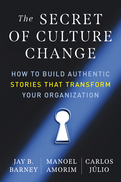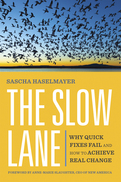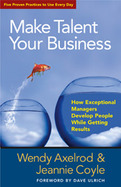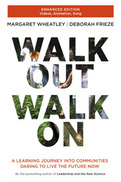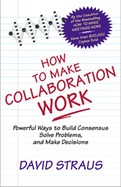Data indicates that most strategic efforts to change a company's culture fail. So how do companies succeed in this endeavor?
A top strategy professor and two highly successful CEOs found that, in companies that had successfully changed their culture, leaders had taken dramatic actions that embodied the new cultural values. These actions inspired stories that became company legends, repeated in every department and handed on to new employees.
Through compiling and analyzing 150 stories from business leaders who have achieved change, they identified 6 attributes that every successful culture change story has in common:
1. The actions are authentic
2. They revolve around the CEO
3. They signal a clean break with the past, and a clear path to the future
4. They appeal to employee heads and hearts
5. They're often theatrical or dramatic
6. They're told, and re-told, throughout the organization
With extensive and inspiring examples of stories containing these attributes, the authors illustrate how readers can harness the power of stories within their company in order to change or create a winning culture to align with any strategy.
2023
Society celebrates leaders who promise fast, easy solutions to the world's problems—but quick fixes are just mirages that fade, leaving us with the same broken systems. The truth is, effective social change happens through slow, intentional actions. The author, a globally acclaimed social entrepreneur, offers a 5-step process for taking the slow lane to change-the lane that gets you to the right place faster:
- Listening—Listen to build trust, which can change hearts and minds and allow for something new to emerge.
- Holding the urgency—Accept that even in moments of crisis you can move only at the speed of trust instead of rushing into action.
- Sharing the agency—Create an inclusive environment where everyone can lead.
- Healing democracy—Build bridges that allow marginalized people to participate.
- Maintaining curiosity—Be inspired by nontraditional sources.
Using dozens of examples—prison reform in England, urban development in Venezuela, healthcare in the Navajo Nation, early childhood education in New York, and many more—The Slow Lane shows how, by following the principles taught in this book, readers can create lasting change.
Shows how managers can develop the talents of their employees naturally, efficiently and effectively.
-
Shows how managers can readily embed talent development into their day, going well beyond the usual coaching and training programs--an incredible complement to talent management systems
-
Offers five exceptional development practices derived from research with managers and professionals at twenty-eight companies
-
Filled with real examples and easily accessible advice
Most organizations report that talent is the key to their success. Yet they struggle mightily to develop their workforce. McKinsey's ten-year follow-up to its famous "War for Talent" concluded that heavy instruments in talent managements processes have been "insufficient, superficial, and wasteful." Managers consistently say they don't feel they have the time or skills to do the job. Even if they want to develop their people--they are overloaded just meeting their numbers.
Some managers, however, are able to deliver business results and develop their people in significant ways. Wendy Axelrod and Jeannie Coyle studied these "Exceptional Development Managers" in companies like Adidas, Microsoft, Siemens, Merck, Corning, and Kraft. The authors uncovered five practices these managers shared. Without fail they integrated development into day-to-day work, rather than making it a separate event. They leveraged the importance of emotions and trust in making work more developmental. They helped their staff find the right development partners. They taught their people how to increase their impact by navigating organizational politics. And they infused their departments' environment with abundant development opportunities. In all, these managers' efforts were deliberate, resourceful, and continuous.
Axelrod and Coyle offer a wealth of real-life examples and specific techniques to help readers apply these practices for themselves. Working in this way not only pays huge dividends for managers' employees and organizations--it makes the manager's job far richer and more rewarding.
2013
Provides an intimate experience of how seven healthy and resilient communities took on intractable problems by working together in new and different ways.
The Enhanced Edition includes 25 minutes of animation, video, and audio. The animation shows the “Two Loops Theory of Change” with a voiceover from co-author Deborah Frieze. Three videos show inspirational “Walk On” communities in Brazil, South Africa, and India. This edition also includes the “Walk Out Walk On” theme song.
- 2012 Nautilus Silver Award Winner in Social Change Category
-
By the bestselling author of Leadership and the New Science and Turning to One Another
-
Provides an intimate experience of how seven healthy and resilient communities took on intractable problems by working together in new and different ways
-
immerses the reader in the experience of each community through stories, essays, first-person accounts, and over 100 color photos
This is an era of increasingly complex problems, fewer and fewer resources to address them, and failing solutions. Is it possible to find viable solutions to the challenges we face today as individuals, communities, and nations? This inspiring book takes readers on a learning journey to seven communities around the world to meet people who have "walked out" of limiting beliefs and assumptions and "walked on" to create healthy and resilient communities. These Walk Outs who Walk On use their ingenuity and caring to figure out how to work with what they have to create what they need.
In India, we meet people from Shikshantar, a community that is rejecting the modern culture of money, with its emphasis on self-interest and scarcity, in favor of a gift culture based on generosity and reciprocity. In Zimbabwe, we discover the capacity people have to adapt and invent new ways of surviving and thriving in the face of total systems collapse.
Through essays, stories, and beautiful color photographs, Wheatley and Frieze immerse us in these communities that are accomplishing extraordinary things by relying on everyone to be an entrepreneur, a leader, an artist. From Mexico to Greece, from Columbus, Ohio to Johannesburg, South Africa, we discover that every community has within itself the ingenuity, intelligence, and inventiveness to solve the seemingly insolvable. "It's almost like we discovered a gift inside ourselves," one Brazilian said, "something that was already there.
By the coauthor of the classic How to Make Meetings Work (more than 600,000 copies sold) and the originator of many of the most popular group decision-making methods
Describes five time-tested principles for making collaborative efforts more effective, efficient, and even joyful
Offers examples from Fortune 500 companies, nonprofit organizations, and communities to illustrate the principles in action
Every day we work with others to solve problems and make decisions, but the experience is often stressful, frustrating, and inefficient. In How to Make Collaboration Work, David Straus, a pioneer in the field of group problem solving, introduces five principles of collaboration that have been proven successful time and again in nearly every conceivable setting.
Straus draws on his thirty years of personal and professional experience to show how these principles have been applied by organizations as diverse as Ford Motor Company, the U.S. Environmental Protection Agency, Harvard Business School Publishing, Boston Public Schools, Kaiser Permanente, the city of Denver, and many others.
How to Make Collaboration Work shows how collaboration can become a joy rather than a chore-a kind of chemical reaction that releases far more energy than it consumes.
- By the coauthor of the classic How to Make Meetings Work (more than 600,000 copies sold) and the originator of many of the most popular group decision-making methods
- Describes five time-tested principles for making collaborative efforts more effective, efficient, and even joyful
- Offers examples from Fortune 500 companies, nonprofit organizations, and communities to illustrate the principles in action


